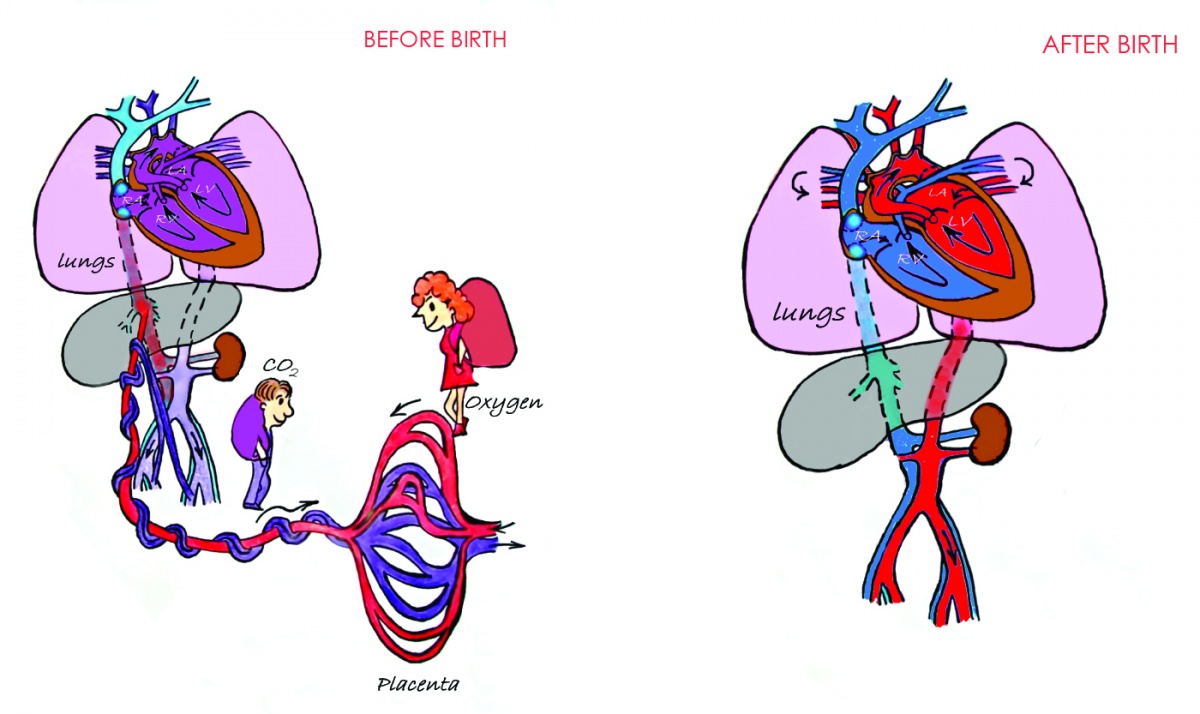Every May, we take a moment to appreciate the mothers in our lives. One of the first miracles of motherhood begins even before the baby is born. Let’s think of everything that is programmed to happen as the baby takes her first breath.
The lungs of a fetus are at the ready, but benched for action during pregnancy. So, the puzzle is: how does a fetus get oxygen while bypassing its lungs?
First, let’s recap how adult circulation works and the role that lungs play.
It all starts as you breathe in and oxygen enters your lungs. This oxygen fuels your blood, which then travels to your heart. It enters through the left atrium and from there travels into the left ventricle. This oxygenated blood is then pumped into the aorta and arteries, which sends it into the upper and lower parts of the body. The aorta is the highway of the exchange and sends the blood through “regional roads” (arteries) and “alleys” (capillaries) and passes the oxygen into the tissues. Once the blood gives out all of its oxygen, it collects in the veins and travels to the right atrium and off to the right ventricle. From thereon, it travels back up to the lungs to get more oxygen.
That’s not how a fetus gets oxygen, however. Fetal lungs are closed off during pregnancy because they are filled with amniotic fluid. Yet the fetus still needs oxygen. This is why there is a detour in place. The mother’s oxygenated blood goes to the placenta, which filters out blood gases, such as oxygen, to the fetus. The blood itself does not cross over into the fetal circulatory system through this process.
But this still doesn’t explain how the blood can travel without going to the lungs. After all, the circulatory system of a fetus must be wired in such a way that the transition from a fetus to a baby is seamless. The baby will need oxygen immediately and there is no room for error. So, a completely different system that does not include the lungs is not an option. Mother Nature has it solved.

The blood from the umbilical cord connects with the veins of the fetus and together returns to the right atrium. If the lungs were open for business, the next stop would be the right ventricle and from thereon, it would travel back up to the lungs. But there’s a dead end, because the lungs are out of service. Luckily, there is a security patch in place. There is a small oval window or hole (patent foramen ovale) open between the right and left atria. The blood then skips the trip to the lungs and goes straight through the opening into the left atrium, through the left ventricle and continues to circulate through the circulatory system. The blood goes to the tissues and gives oxygen to the cells, and then back through the vein system towards the heart. At the same the time, the flow of blood separates and flows back through the umbilical cord towards the placenta. However, there’s a second flow of blood. The deoxygenated blood that is returning from the upper part of the body of the fetus into the right atrium must also skip the journey towards the lungs. Luckily, there’s another security patch to address that. There is a shortcut access route (ductus arteriosus) that connects the aorta with the pulmonary artery, thus avoiding the lungs and completing a full cycle of the circulatory system.
As the baby is born, her chest and lungs expand and the amniotic fluid is partially absorbed. Then, within a couple of days, both the oval window and the shortcut access route will close and let the baby’s lungs do the work. For some this might not happen, resulting in a heart condition.
Now, take a breath.

